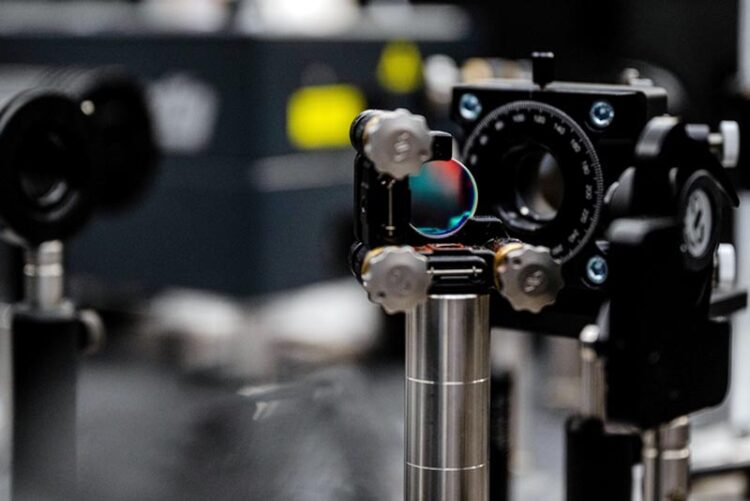Fast light pulse triggers charge transfer into water

The study was only made possible by the new laser laboratories in the ZEMOS research building, where all external interference signals are minimised.
Credit: © RUB, Marquard
In certain molecules, the so-called photoacids, a proton can be released locally by excitation with light. There is a sudden change in the pH value in the solution – a kind of fast switch that is important for many chemical and biological processes. Until now, however, it was still unclear what happens at the moment of proton release. This is exactly what researchers in the Cluster of Excellence Ruhr Explores Solvation RESOLV at Ruhr University Bochum, Germany, have now been able to observe in an experiment using new technology. They observed a beating between solute and solvent initiating a tiny quake, lasting only three to five picoseconds, before the proton starts to detach. They report on this in the journal Chemical Sciences of 16 March 2023.
So far, the focus has been on dye or base
One of the most studied so-called photoacids is pyranine, the fluorescent dye used, for instance, in yellow highlighters. “Despite a wealth of experimental studies, the process that is at the very beginning of proton detachment still remained the subject of controversial debate,” reports Professor Martina Havenith, spokesperson for RESOLV. However, the entire detachment process also happens on a time scale of only 90 picoseconds. A picosecond corresponds to a millionth of a millionth of a second.
While previous studies focused mainly on the change of the dye after light excitation, the team was able to observe the change of the solvent, in this case water, during this process for the first time. This was achieved with the help of a newly developed technique, “Optical Pump THz Probe Spectroscopy”.
Ultra-fast energy transmission
“We were able to follow how there is an oscillation at the beginning, which then subsides subsequently,” describes Martina Havenith. “It is exciting to see that the solvent response that promotes excited-state proton transfer could be caught in the act.” The initial ultrafast transfer of energy within less than a picosecond causes a restructuring of the water molecules in the immediate vicinity and opens the way for the subsequent proton migration.
The detection was made possible by the new laser laboratories in the ZEMOS research building. There, all external interference signals, such as those caused by electromagnetic radiation, temperature and humidity fluctuations, are minimised. Only then is it possible to detect even the tiniest tremors in a water jet with the dye.
Cooperation partners
The accompanying simulations were carried out at the University of California at Berkeley in the research group of Martin Head-Gordon. It belongs to CALSOLV, the sister institute of RESOLV.
Journal: Chemical Science
DOI: 10.1039/D2SC07126F
Method of Research: Experimental study
Subject of Research: Not applicable
Article Title: Caught in the act: real-time observation of the solvent response that promotes excited-state proton transfer in pyranine
Article Publication Date: 16-Mar-2023
Media Contact
All latest news from the category: Life Sciences and Chemistry
Articles and reports from the Life Sciences and chemistry area deal with applied and basic research into modern biology, chemistry and human medicine.
Valuable information can be found on a range of life sciences fields including bacteriology, biochemistry, bionics, bioinformatics, biophysics, biotechnology, genetics, geobotany, human biology, marine biology, microbiology, molecular biology, cellular biology, zoology, bioinorganic chemistry, microchemistry and environmental chemistry.
Newest articles

NASA: Mystery of life’s handedness deepens
The mystery of why life uses molecules with specific orientations has deepened with a NASA-funded discovery that RNA — a key molecule thought to have potentially held the instructions for…

What are the effects of historic lithium mining on water quality?
Study reveals low levels of common contaminants but high levels of other elements in waters associated with an abandoned lithium mine. Lithium ore and mining waste from a historic lithium…

Quantum-inspired design boosts efficiency of heat-to-electricity conversion
Rice engineers take unconventional route to improving thermophotovoltaic systems. Researchers at Rice University have found a new way to improve a key element of thermophotovoltaic (TPV) systems, which convert heat…



